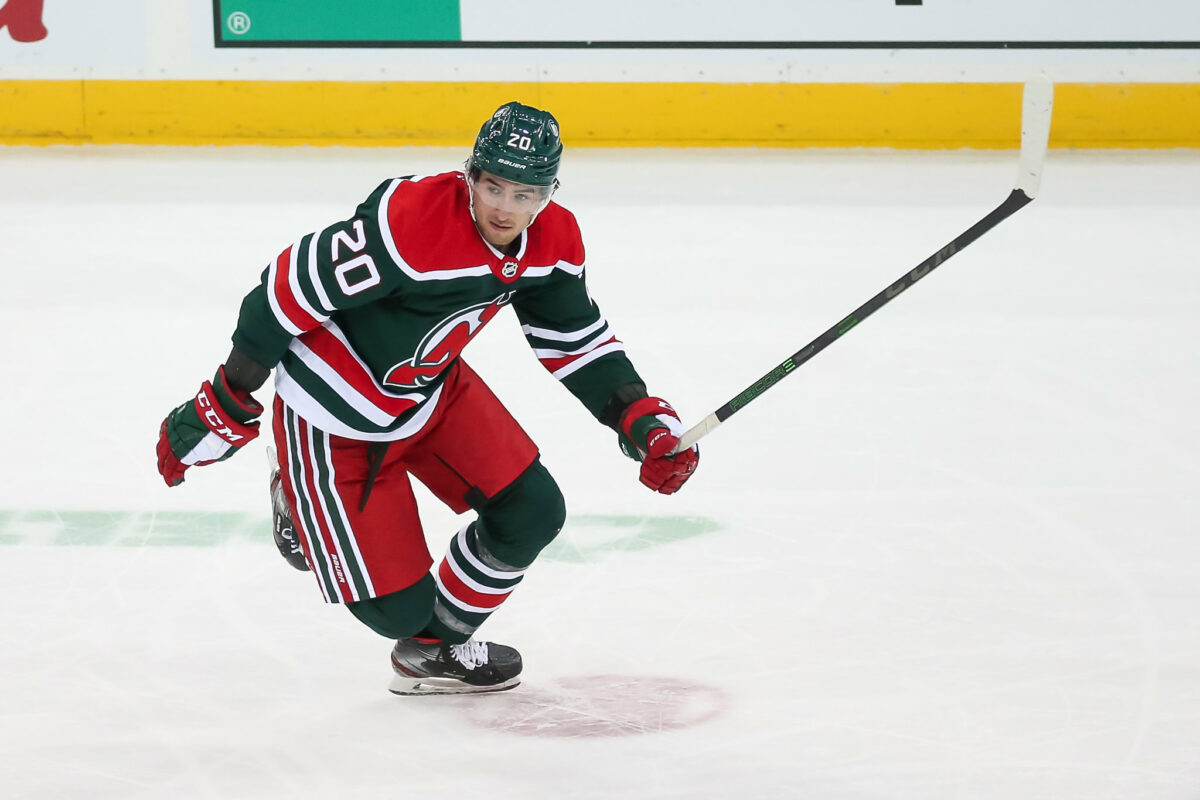Yesterday morning, our Seattle Kraken Mock Expansion Draft went live ahead of the actual expansion draft, which will take place on July 21. The rules for the Kraken are the same as they were for the Vegas Golden Knights in 2017. Teams could protect seven forwards, three defensemen, and a goalie, or they could protect eight skaters total and a goalie.
But it wasn’t just about making protection lists for this mock expansion draft. With our armchair general managers having the freedom to make trades, there was the opportunity to take advantage of some other team’s salary cap and protection woes to improve the New Jersey Devils’ roster. So as armchair GM of the Devils, I decided to take advantage. Let’s go over some of those trades, as well as the players I decided to protect from the Devils’ roster using the 7-3-1 format, the most sensible choice given the team’s makeup.
Pre-Expansion Trades
Before getting into the protection list, it makes sense to cover the trades because there is one that affected my protection decisions. Here are the moves:
- In a three-way trade, the Tampa Bay Lightning acquired defenseman Rasmus Ristolainen, the Buffalo Sabres acquired center Tyler Johnson, a 2021 third-round pick and retained $2.7 million of Ristolainen’s salary. The Devils acquired a 2023 third-round pick and retained $1.35 million of Ristolainen’s salary.
- In a three-way trade, the Vegas Golden Knights acquired D Nick Leddy, the Devils acquired a 2021 second-round pick and retained 50 percent of Leddy’s $5.5 million salary. The New York Islanders acquired C Nicolas Roy and a 2021 second-round pick.
- The St. Louis Blues traded defenseman Vince Dunn to the Devils for a 2021 first-round pick (from the Islanders).
The first two trades are pretty simple. The Devils don’t acquire an actual player, but they get two draft picks for retaining portions of Ristolainen and Leddy’s deals. The pick obtained by the Devils in the Leddy trade is their own draft choice, which they sent to the Golden Knights when they acquired Nikita Gusev in July 2019. And with the Devils $14,377,501 BELOW the cap floor, retaining salary on both those players for one year helps them get closer to the floor without limiting their long-term cap flexibility.

Getting that second-round pick in return proved to be valuable. To improve the Devils’ roster, I decided to send the New York Islanders’ first-round pick, acquired in the Kyle Palmieri trade, to the Blues for defenseman Vince Dunn. That Islanders pick will be 28th overall at the entry draft next weekend, while the selection the Devils received back from Vegas will be 35th overall. That’s not a significant difference in value. And with a draft that could be wild and unpredictable, having an early second makes a lot of sense since you don’t know which prospects could slip at the entry draft.
Related: Devils News & Rumors: Labanc, Henrique & More
Giving up a first-rounder (a late one at that) for Dunn may be a bit pricey. But it’s acceptable after receiving a second in return for retaining a portion for Leddy’s deal. Dunn is only 24 years old and is a restricted free agent this offseason. Per Evolving-Hockey, he projects to land a two-year deal at a cap hit of $3.144 million. That’s a fair price for someone who’ll provide a top-four upgrade and fits in with the young core the Devils are building around. And since the Blues couldn’t protect him, it made sense to make the trade.
The Protection Decisions
Since I acquired Dunn before the expansion draft, that means using a protection slot on him. But don’t worry, even after the trade, it shouldn’t create any protection issues on the Devils’ back end. Before trading for Dunn, the three defensive protection slots would’ve come down to Will Butcher, Damon Severson, P.K. Subban and Jonas Siegenthaler. The latter three would’ve been my choices, with Butcher exposed to the Kraken. But Dunn ended up getting the final slot, leaving both Butcher and Siegenthaler exposed. Add the forwards and a goalie, and here’s how my 7-3-1 format looked:
Forwards:
- Nico Hischier, Jesper Bratt, Miles Wood, Pavel Zacha, Janne Kuokkanen, Yegor Sharangovich, Andreas Johnsson
Defense:
- Subban, Severson, Dunn
Goalie:
- Mackenzie Blackwood
The decisions up front weren’t difficult. Hischier and Bratt were locks and the same for Zacha after his 2020-21. Sharangovich and Kuokkanen were among the Devils’ best rookies this season, and they look to have long-term futures with the club. Wood had a rebound season and finished at a 25-goal pace over 82 games, so that wasn’t a hard decision either.
That left the seventh and final slot up front between Johnsson and Michael McLeod. It’s not going to be a popular decision, but I decided to protect Johnsson over McLeod, who the Kraken ended up selecting in this mock draft. The reason I chose to protect Johnsson is that he’s a prime rebound candidate for next season. His individual point percentage dropped to 40 percent in 2020-21 after being 64.5 percent over his previous two seasons. If his IPP reverts to the mean, he’ll most likely return closer to the 40-45 point player the Devils thought they were getting when they acquired him from the Toronto Maple Leafs.

Losing McLeod to the Kraken may hurt a bit. He took a significant step forward this season and finished with nine goals in 52 games — a 14-goal pace over 82 games. With that said, he’s not irreplaceable. Mikhail Maltsev finished this season on a 15-goal, 22-point pace over 82 games, nearly identical to McLeod’s production. Maltsev also had better underlying metrics than McLeod, so it’s not impossible to think he could be the team’s fourth-line center. The Devils could always look to free agency for someone like Tomas Nosek as well. The point is fourth-liners aren’t hard to replace.
On defense, there weren’t many hard decisions to make, even after acquiring Dunn. Subban may have a $9 million cap hit, but he only has one year left on his deal. Plus, that helps the Devils get closer to the cap floor. Severson is the team’s best defenseman as of now, so protecting him was a no-brainer. And with Seattle passing on Siegenthaler and Butcher, the Devils’ defensive depth remains intact.
Related: Predicting the Devils Expansion Draft Protection List
Finally, there was the goalie decision. Other than Blackwood, the Devils don’t have anyone worth protecting, so that was an easy decision too. He may have struggled this season, but a rough bout with COVID was partly to blame. With a full offseason to rest, he should be good to go once training camp begins in September.
How Different Will the Real Thing Be?
Aside from Dunn, unless the Devils acquire him or any other defender before July 21, Siegenthaler will be protected in the actual expansion draft. Otherwise, this mock will probably be close to reality. The only change I can see Devils GM Tom Fitzgerald making is protecting McLeod over Johnsson. Devils head coach Lindy Ruff seemed to value McLeod down the stretch as a dependable fourth-line center and penalty-killer. He’s only 23 years old, too, so I would not at all be shocked if they used their seventh slot up front on him.
All in all, Fitzgerald shouldn’t have to worry much about losing a significant piece from his roster. Ty Smith and Jack Hughes are exempt, meaning the Kraken cannot select them. And all of the team’s top prospects are exempt from the Kraken drafting them as well. With protection lists getting revealed this weekend, we should find out soon enough. So let the offseason madness begin.
* * *
Advanced stats from Natural Stat Trick, Evolving-Hockey